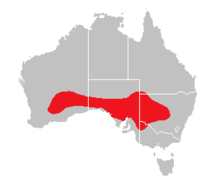Ctenophorus fordi
| Mallee dragon | |
|---|---|
| Scientific classification | |
| Kingdom: | Animalia |
| Phylum: | Chordata |
| Class: | Reptilia |
| Order: | Squamata |
| Suborder: | Iguania |
| Family: | Agamidae |
| Genus: | Ctenophorus |
| Species: | C. fordi |
| Binomial name | |
| Ctenophorus fordi | |
 | |
| Distribution of Ctenophorus fordi | |
| Synonyms[1][2] | |
| |
Ctenophorus fordi, commonly known as the Mallee dragon, Mallee military dragon,[3] or Mallee sand-dragon,[2] is a species of agamid lizard occurring in the arid parts of southern Australia.[3][1]
Description
Adult Mallee dragons range in colour from yellow-brown to reddish-brown, with a pale midlateral stripe, head and body flecked with dark brown or black, and a white underside. The throat of males is marked with black spots or bars, which often connect to form a 'V' shape. Adults have a total length (including tail) of 16.5–19 cm (6.5–7.5 in).[4][5][6]
Distribution
Mallee dragons are found throughout the arid to semi-arid parts of south-eastern Western Australia, across central South Australia to north-western Victoria, into north-western and central-western New South Wales, as well as into a small portion of south-western Queensland.[4][5][7][6]
Ecology and behaviour
The Mallee dragon lives in sandy arid to semi-arid areas of Mallee woodland and spinifex, as well as vegetated sand dunes.[7][8] They prefer areas of Mallee that haven't been burnt for around 30 years, when spinifex cover is at its maximum.[9] Emerging from dormancy in August, males appear about four weeks earlier than females.[6] Active even on very hot days, they forage in sandy, open areas, and will dash for cover into nearby grasses or low bushes if disturbed or pursued.[5][7][6] Males are territorial.[6]
Diet
One of only a few Australian lizard species specialized in eating ants, their limited diet consists primarily of ants.[4][10]
Reproduction
Mating occurs in spring. Multiple clutches of 2–3 eggs are deposited up to three times a season, with eggs hatching after 50–70 days.[6]
Conservation actions
Although considered to be of 'Least Concern' by the IUCN, the Mallee Dragon occurs in several protected areas, including the Currawinya National Park in Queensland, the Yathong Nature Reserve in New South Wales, and the Murray-Sunset National Park in Victoria.[1]
References
- 1 2 3 4 5 Cogger, H.; Melville, J.; Wilson, S. & Craig, M. (2017). "Ctenophorus fordi". IUCN Red List of Threatened Species. IUCN. 2017: e.T83410150A83453708. doi:10.2305/IUCN.UK.2017-3.RLTS.T83410150A83453708.en. Retrieved 18 May 2018.
- 1 2 Ctenophorus fordi at the Reptarium.cz Reptile Database. Accessed 19 May 2018.
- 1 2 "Ctenophorus fordi (Storr, 1965)". Atlas of Living Australia. Retrieved 18 May 2018.
- 1 2 3 Cogger, H. (2000) Reptiles and Amphibians of Australia, Reed New Holland, Sydney, New South Wales, ISBN 1876334339
- 1 2 3 Wilson, S., Swan, G. (2013) A Complete Guide to Reptiles of Australia, New Holland Publishers, Sydney, New South Wales, ISBN 9781921517280
- 1 2 3 4 5 6 Swan, M., Watharow, S. (2005) Snakes, Lizards and Frogs of the Victorian Mallee, CSIRO Publishing, Collingwood, Victoria, Australia ISBN 0643091343
- 1 2 3 Swan, G., Shea, G., Sadlier, R. (2004) A Field Guide to Reptiles of New South Wales, Reed New Holland, Sydney, New South Wales, ISBN 187706906X
- ↑ Pianka, E. R. (1972). "Zoogeography and speciation of Australian desert lizards: an ecological perspective". Copeia. 1972 (1): 127–145. doi:10.2307/1442789.
- ↑ Nimmo, D. G.; Kelly, L. T; Spence-Bailey, L. M.; Watson, S. J.; Taylor, R. S.; Clarke, M. F. & Bennet, A. F. (2013). "Fire Mosaics and Reptile Conservation in a Fire‐Prone Region". Conservation Biology. 27 (2): 345–353. doi:10.1111/j.1523-1739.2012.01958.x.
- ↑ Abensperg-Traun, M. M. & Steven, D. (1997). "Ant‐and termite‐eating in Australian mammals and lizards: a comparison". Austral Ecology. 22 (1): 9–17. doi:10.1111/j.1442-9993.1997.tb00637.x.
Further reading
- Sadlier, R.A., Shea, G.M. (1989). "The reptiles of Mungo National Park and the Willandra Lakes region". Herpetofauna, 19(2), pp. 9–27.
